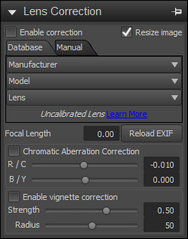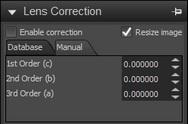|
Detail tools |
  
|
The Detail tab on the Tools panel lets you access controls that let you sharpen, blur, adjust noise, apply lens corrections or distortions, and add effects, such as vignette or color inversion.
The Sharpening section lets you adjust how sharp or how soft the details are in your image. Amount adjusts the overall sharpness, while Sensitivity limits what portions of your image are sharpened.

A high Sensitivity value results in less of your image being sharpened. If sharpening your image makes noise or highly detailed areas too distracting or too sharp, then try raising the Sensitivity value.
Note: Fine-detailed control tools, like Sharpening, should be applied and evaluated while looking at the image at the 100% zoom level, either in the Preview panel or with the Magnifier
*Available only in Corel AfterShot Pro prior to version 1.1.1.x.
RAW Noise is an image improvement process that you can use very early in the image editing workflow to provide the highest quality final images. The feature can be applied only to RAW files.
| • | Raw Impulse Noise Removal — enables the automatic detection and removal of impulse noise (single black, white, or colored pixels). |
| • | Raw Noise — reduces noise. You can control the strength of the noise reduction. |
| • | Threshold — sets the level of sensitivity for noise detection in the image. |
Note: Applying RAW Noise enables RAW Impulse Noise Removal, but you can apply RAW Impulse Noise Removal without enabling RAW Noise.
Lens correction fixes lens distortion. While zoom lenses with a large range of focal lengths show the greatest lens distortion, even fixed-focal length, or "prime" lenses, can cause some types of distortion. The following types of lens distortion can quickly and easily be corrected in Corel AfterShot Pro: Barrel and Pin Cushion distortion, Chromatic Aberration, and Vignetting.

Barrel and Pin Cushion distortion is commonly referred to simply as lens distortion. This is caused from nonuniform magnification of the image from the outside of the image (perimeter) to the center. Barrel distortion refers to a rounded effect in an image caused by diminished lens magnification towards the edges. Pin cushion distortion refers to a pinched or narrowed appearance at the sides of an image. Each lens has its own Barrel and Pin Cushion characteristics, and by analyzing a set of images from a lens at all focal lengths, this distortion can be removed. Corel AfterShot Pro includes profiles for several hundred lens and camera combinations.
Chromatic Aberration distortion (known as CA distortion) is a result of the nonuniform bending of light as it passes through a lens. The result is a color fringe (often appears purple) and uneven colors around edge details in high contrast scenes, such as branches of a tree silhouetted against a bright sky. Zoom lenses, particularly at their widest and longest focal lengths, exhibit the most severe distortion. CA distortion can be removed by adjusting the data for the colors that show the most distortion.
Vignetting is the darkening of corners of an image due to light fall-off, and can be caused by optics (the lens itself), the sensor (many sensors are less sensitive to light that hits the sensor at an angle), or from other causes like a filter or lens hood that shades the corners of an image. Vignetting can be corrected by brightening the corners of an image. In some cases, photographers chose to add a vignette effect to their photos to draw focus to the central subject. You can use Corel AfterShot Pro to remove an unwanted vignette or add a vignette. When you add a vignette, it is always performed on the cropped portion of the image, while correcting vignette is applied to the entire original frame.
The Lens Correction section contains the following controls:
The top section controls Barrel and Pin Cushion distortion, and contains two tabs: Database and Manual.
The Database tab is used when you want to correct your images based on camera and lens profiles built into Corel AfterShot Pro.
| • | Enable correction — toggles Lens Correction on or off. |
| • | Resize image — enable to automatically scale the image to fill the image frame. Do not enable if you want to fill the empty sections of your image manually. |
| • | Manufacturer, Model, Lens — these drop-down menus show what camera and lens Corel AfterShot Pro assumes your image was taken with. Some cameras and lenses include data in the image file that allows the application to determine exactly what camera and lens was used, but other times the application "guesses" the closest option based on the data available. You can change incorrect guesses by selecting the correct manufacturer, camera model, and lens in the lists. These determine which Lens Distortion profile to use when removing distortion. |
| • | Focal Length — shows the focal length setting for the lens at the time the image was taken. You can set the focal length manually if the image file doesn't include this information. |
| • | Reload EXIF — click this button to have Corel AfterShot Pro re-read the EXIF data from the selected image, guess the camera and lens type, and select the appropriate entries in the drop-downs. |
The Manual tab lets you manually enter correction parameters instead of using correction parameters from profiles built into the application. This is useful for lenses that are not yet in the lens correction database.
If you want more information about lens correction parameters in general, and how to determine them, you can visit the following third-party site: http://wiki.panotools.org/Lens_correction_model.

The Chromatic Aberration section contains the following controls:
| • | Chromatic Aberration Correction — toggles Chromatic Aberration Correction on or off. This control is independent of other types of lens correction. |
| • | R / C — controls the shift of colors along the Red/Cyan color axis. |
| • | B / Y — controls the shift of colors along the Blue/Yellow color axis. |
The Vignette Correction section contains the following:
| • | Enable vignette correction — toggles Vignette control on or off. This control is independent of other types of lens correction. |
| • | Strength — controls how light (positive or right) or dark (negative or left) the correction will be. |
| • | Radius — controls how far into the image the correction should extend. |
This simple tool allows you to:
| • | Mirror your image (from left to right). |
| • | Invert the colors (like a film negative). This option can be useful when working with scanned negatives. |
![]()
© 2013 Corel Corporation